Michel Ney
Michel Ney, 1st Duke of Elchingen, 1st Prince of the Moskva (pronounced [miʃɛl nɛ]; 10 January 1769 – 7 December 1815) was a French military commander and Marshal of the Empire who fought in the French Revolutionary Wars and the Napoleonic Wars.
Michel Ney | |
|---|---|
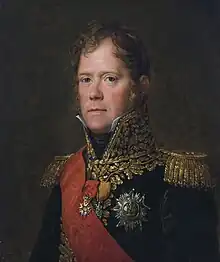 Portrait by François Gérard, 1805 | |
| Nickname(s) |
|
| Born | 10 January 1769 Sarrelouis, France; modern-day Germany |
| Died | 7 December 1815 (aged 46) Paris, France |
| Buried | |
| Allegiance | |
| Branch | French Army |
| Service years | 1787–1815 |
| Commands held | |
| Wars | |
| Awards | |
| Signature | |
The son of a cooper from Saarlouis, Ney worked as a civil servant until 1787 when he enlisted in a cavalry regiment, right before the outbreak of French Revolution. Distinguishing himself as a cavalry officer in the War of the First Coalition, he quickly rose through the ranks and, by the Battle of Hohenlinden (1800), he had been promoted to divisional general. On Napoleon's proclamation of the French Empire, Ney was named one of the original 18 Marshals of the Empire. He played an instrumental role during Napoleon's subsequent campaigns, seeing action at Elchingen (1805), Jena (1806) and Eylau (1807). Ney commanded the French rearguard during the disastrous invasion of Russia, for which he was lauded "the bravest of the brave" by the emperor.
After Napoleon's defeat by the Sixth Coalition in 1814, Ney pressured the emperor to abdicate and pledged his allegiance to the restored Bourbon monarchy. He rejoined Napoleon during the Hundred Days but met defeat at the Battle of Waterloo (1815), after which he was charged with treason by the restored monarchy and executed by firing squad.
Early life
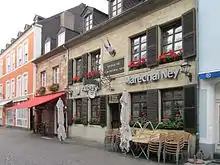
Ney was born in the town of Sarrelouis, in the French province of Lorraine, along the French–German border. He was the second son of Pierre Ney (1738–1826), a master cooper and veteran of the Seven Years' War, and his wife Marguerite Greiveldinger.[1] He was the paternal grandson of Matthias Ney (1700–1780) and wife Margarethe Becker (d. 1767), and the maternal grandson of Valentin Greiveldinger and wife Margaretha Ding.[2]
His hometown at the time of his birth comprised a French enclave in the predominantly German region of Saarland, and Ney grew up bilingual, due to his German roots.[3] He was educated at the Collège des Augustins in Sarrelouis until 1782, when he began working as a clerk in a local notary's office, and in 1784 was employed in mines and forges.[4]
Military career
French Revolutionary Wars
.jpg.webp)
Life as a civil servant did not suit Ney, and he enlisted in the Colonel-General Hussar Regiment in 1787.[2] Under the Bourbon monarchy, entry to the officer corps of the French Army was restricted to those with four quarterings of nobility (i.e., two generations of aristocratic birth). However, Ney rapidly rose through the non-commissioned officer ranks.
Following the French Revolution, Ney continued to serve in what was now the French Revolutionary Army, in the Army of the North. In September 1792 he saw action at the Battle of Valmy and in October was commissioned as an officer under the Republic. As an officer he participated in the Battle of Neerwinden in 1793 and was wounded at the Siege of Mainz, also in 1793. in June 1794, he was transferred to Army of Sambre-et-Meuse.
Ney was promoted to brigadier general in August 1796, and commanded cavalry on the German fronts. On 17 April 1797, during the Battle of Neuwied, Ney led a cavalry charge against Austrian lancers trying to seize French cannons. The lancers were beaten back, but Ney's cavalry were counter-attacked by heavy cavalry. During the mêlée, Ney was thrown from his horse and captured in the vicinity of the municipality of Dierdorf; on 8 May he was exchanged for an Austrian general.[5] Following the capture of Mannheim, Ney was promoted to géneral de division on 28 March 1799 and was given brief command over the Army of the Rhine from 25 September to 23 October. [6][7] Later in 1799, Ney commanded cavalry in the armies of Switzerland and the Danube.[6] At Winterthur, Ney received wounds in the thigh and wrist. After recovering he fought at Hohenlinden under General Jean Victor Marie Moreau in December 1800.[6] From September 1802, Ney commanded French troops in Switzerland and performed diplomatic duties.
Napoleonic Wars
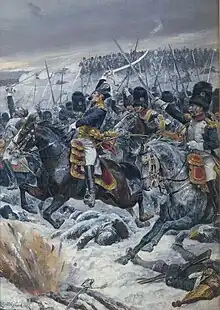
On 19 May 1804, Ney received his marshal's baton, emblematic of his status as a Marshal of the Empire, the Napoleonic era's equivalent of Marshal of France.[8] In the 1805 campaign, Ney took command of the VI Corps of the Grande Armée and was praised for his conduct at Elchingen.[8] In November 1805, Ney invaded Tyrol, capturing Innsbruck from Archduke John. In the 1806 campaign, Ney fought at Jena and then occupied Erfurt. Later in the campaign, Ney successfully besieged Magdeburg. In the 1807 campaign, Ney arrived with reinforcements in time to save Napoleon from defeat at Eylau. Later in the campaign, Ney fought at Güttstadt and commanded the right wing at Friedland. On 6 June 1808, Ney was made Duke of Elchingen.[8] In August 1808, he was sent to Spain in command of the VI Corps and saw action in a number of minor engagements. In 1809, he skirmished with an Anglo-Portuguese force under Sir Robert Wilson at Puerto de Baños. In 1810, Ney joined Marshal André Masséna in the invasion of Portugal, where he captured Ciudad Rodrigo and Almeida, and saw further action on the River Côa, and a defeat at the Bussaco. The French army followed the retreating allies to the Lines of Torres Vedras, a scorched earth trap prepared by Wellington in absolute secrecy. After losing 21.000 men of 61.000 in several months of hunger, Masséna and Ney were forced to retreat due to lack of food and supplies, see also attrition warfare against Napoleon.[9] Ney engaged Wellington's forces in a series of rearguard actions (Pombal, Redinha, Casal Novo, and Foz de Arouce) through which he managed to delay the pursuing Coalition forces long enough to allow the main French force to retreat in 1811. He was ultimately removed from his command for insubordination.[8]
Russia to Fontainebleau
_-_Marshall_Ney_at_retreat_in_Russia.jpg.webp)

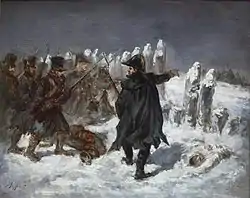
Ney was given command of the III Corps of the Grande Armée during the invasion of Russia in 1812. At Smolensk, Ney was wounded in the neck but recovered enough to later fight in the central sector at Borodino. During the retreat from Moscow, Ney commanded the rearguard (and was known as "the last Frenchman on Russian soil" when he passed the Niemen on 14 December). After being cut off from the main army during the Battle of Krasnoi, Ney managed to escape in a heavy fog over the Dnieper River, but not without heavy losses, and to rejoin it in Orsha, which delighted Napoleon.[8] For this action Ney was given the nickname "the bravest of the brave" by the emperor.[8]
Ney crossing the Dniepr
Ney lost more than half his strength; almost all the cavalry and all the artillery, with the exception of two guns, had disappeared.[10] The terrible defeat of the III Corps was thorough enough to induce the chivalrous Miloradovich to extend another honorable surrender to Ney.[11] In the early evening during a heavy fog Ney decided to draw back with 3,000 men.[12] Ney escaped passing around the Russian at Mankovo, following the brook Losvinka for two hours, about 13 km north. At midnight he was informed that the enemy was approaching. In the middle of the night Ney decided to cross the Dnieper, supposedly near the remote hamlet Alekseyevka at a spot which could be used in summer to cross the river but with an almost vertical slope.[13] Ney literally got down on all fours.[14] One by one, but not without heavy losses, leaving guns, horses, part of the detachment and wounded who could not go on.[15] (The river, 110 m wide and the depth could reach up to 2 m, was only frozen since a couple of days and ice broke at several places. When they reached the other bank, they had to climb twelve feet (3.7 m), a very steep slope:[16]) The elements and the Cossacks reduced Ney's contingent to only 800 (900, 2,000?) diehards.[17][18] In the previous 24 hours, 3,000 armed men and 4,000 stragglers had either died or strayed from its ranks.[19] Armand de Briqueville increased the number of abandoned cannons to 6 and increases the number of people who cross to 5-6000.[20]
Ney ordered everyone to move to the Dnieper in the hope of crossing to the opposite bank on the ice. Everyone, from soldiers to officers, was amazed by this decision. To surprised and incredulous stares, Ney declared that if no one supported him, he would go alone. And the soldiers knew very well that this was not posturing. When, finally, the lucky ones reached the opposite shore and already considered themselves saved. To get to the shore, they had to climb another steep icy slope. Many fell back on the ice. Of the three thousand soldiers who accompanied Ney, 2,200 drowned during the crossing.[21][22]
Ney fought at the Berezina and helped hold the vital bridge at Kovno (modern-day Kaunas), where legend portrays Ney as the last of the invaders to cross the bridge and exit Russia.[8] On 25 March 1813, Ney was given the title of Prince of the Moskva.[8] During the 1813 campaign, Ney fought at Weissenfels, was wounded at Lützen, and commanded the left wing at Bautzen. Ney later fought at Dennewitz and Leipzig, where he was again wounded. In the 1814 campaign in France, Ney fought various battles and commanded various units. At Fontainebleau, Ney became the spokesperson for the marshals' revolt on 4 April 1814, demanding Napoleon's abdication. Ney informed Napoleon that the army would not march on Paris; Napoleon responded, "the army will obey me!" to which Ney answered, "the army will obey its chiefs".[23]
When Paris fell and the Bourbons reclaimed the throne, Ney, who had pressured Napoleon to accept his first abdication and exile, was promoted, lauded, and made a Peer of France by the newly enthroned King Louis XVIII. Although Ney had pledged his allegiance to the restored monarchy, the Bourbon court looked down on him because he was a commoner by birth.
Hundred Days

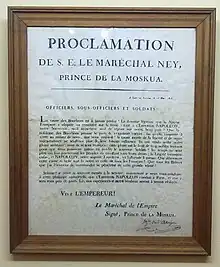
When he heard of Napoleon's return to France, Ney, determined to keep France at peace and to show his loyalty to Louis XVIII, organized a force to stop Napoleon's march on Paris. Ney also pledged to bring Napoleon back alive in an iron cage. On 14 March, on the main square in Lons-le-Saulnier (Jura) Ney joined Napoleon with a small army of 6,000 men.[24] (On 15 March Joachim Murat, King of Naples, declared war on Austria in an attempt to save his throne, starting the Neapolitan War.) Aware of Ney's plans, Napoleon sent him a letter which said, in part, "I shall receive you as I did after the Battle of the Moskowa."[25] Despite Ney's promise to the king, he joined Napoleon at Auxerre on 18 March 1815.
On 15 June 1815, Napoleon appointed Ney as commander of the left wing of the Army of the North. On 16 June, Napoleon's forces split up into two wings to fight two separate battles simultaneously. Ney attacked the Duke of Wellington at Quatre Bras (and received criticism for attacking slowly[26]) while Napoleon attacked Marshal Blücher's Prussians at Ligny. Although Ney was criticized for not capturing Quatre Bras early, there is still debate as to what time Napoleon actually ordered Ney to capture the town.[27] At Ligny, Napoleon ordered General Jean-Baptiste d'Erlon to move his corps (on Napoleon's left and Ney's right at the time) to the Prussians' rear in order to cut off their line of retreat. D'Erlon began to move into position, but suddenly stopped and began moving away, much to the surprise and horror of Napoleon. The reason for the sudden change in movement is that Ney had ordered d'Erlon to come to his aid at Quatre Bras. Without d'Erlon's corps blocking the Prussians' line of retreat, the French victory at Ligny was not complete, and the Prussians were not routed.[28]
At Waterloo on 18 June, Ney again commanded the left wing of the army. At around 3:30 p.m., Ney ordered a mass cavalry charge against the Anglo-Allied lines. Ney's cavalry overran the enemy cannons but found the infantry formed in cavalry-proof square formations which - without infantry or artillery support - he failed to break. The action earned Ney criticism, and some argue that it led to Napoleon's defeat at Waterloo.[26] Debate continues as to the responsibility for the cavalry charge and why it went unsupported. Ney's cavalry also failed to spike the enemy cannons (driving iron spikes into the firing holes) while they were under French control (during the cavalry attack, the crews of the cannon retreated into the squares for protection, and then re-manned their pieces as the cavalry withdrew). Ney's cavalry carried the equipment needed to spike cannons, and spiking the cannons would probably have made them useless for the rest of the battle. The loss of a large number of cannon would have weakened the army and could have caused the Anglo-Allied Army to withdraw from the battle.[29] Ney was seen[30] during one of the charges beating his sword against the side of a British cannon in furious frustration. During the battle, he had five horses killed under him,[31] and at the end of the day, Ney led one of the last infantry charges, shouting to his men: "Come and see how a marshal of France meets his death!"[32] It was as though Ney was seeking death, but death did not want him, as many observers reported.[33]
Trial and execution
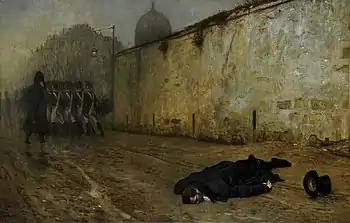

When Napoleon was defeated, dethroned, and exiled for the second time in the summer of 1815, Ney was arrested on 3 August 1815. Marshal Moncey was ordered to assume the presidency of a court-martial convened to try Ney but the marshal declined and was for a time imprisoned for it. The King's government then appointed Marshal Jourdan as president and when it finally convened on 9 November 1815, the court-martial was composed of the Marshals Jourdan, Masséna, Augereau, and Mortier, and the generals Gazan de La Peyriere (instead of Maison who refused), Claparède and Villatte. After long deliberation, the court-martial voted 5-2 to declare itself "non-competent".[34]
After (the King and) the court-martial decided on 11 and 12 November that it did not have jurisdiction, he was tried on 16 November for treason by the Chamber of Peers.[35] In order to save Ney's life, his lawyer André Dupin declared that Ney was now Prussian and could not be judged by a French court for treason as Ney's hometown of Sarrelouis had been annexed by Prussia according to the Treaty of Paris of 1815. Ney ruined his lawyer's effort by interrupting him and stating: "Je suis Français et je resterai Français!" ("I am French and I will remain French!").[36] On 4 December, when the Peers were called to give their verdict, a hundred and thirty-seven voted for the death penalty, seventeen for deportation, and five abstained. Only a single vote, that of the Duc de Broglie, was for acquittal.[37] On 6 December 1815, Ney was condemned, and on 7 December 1815 he was executed by firing squad in Paris near the Luxembourg Gardens. He refused to wear a blindfold and was allowed the right to give the order to fire, reportedly saying:
Soldiers, when I give the command to fire, fire straight at my heart. Wait for the order. It will be my last to you. I protest against my condemnation. I have fought a hundred battles for France, and not one against her ... Soldiers, fire![38]
Ney's execution deeply divided the French public. It was an example intended for Napoleon's other marshals and generals, many of whom were eventually exonerated by the Bourbon monarchy. Ney was buried in Paris at Père Lachaise Cemetery.
Alleged survival
Records in Charleston, South Carolina, indicate the arrival of a "Peter Stewart Ney" the year following Ney's execution. Ney's father was named Peter, and his mother's maiden name was Stewart. "Peter Ney" served as a school teacher in Rowan County, North Carolina until his death on 15 November 1846. Supposedly, upon hearing of the death of Napoleon in 1821, "Peter Ney" slashed his own throat with a knife, nearly killing himself. Upon his death, his last words were "I am Ney of France".[39] His body was exhumed twice, in 1887 and 1936, but both times no conclusive proof emerged.
However, there is evidence contradicting this legend, the main being that the execution of Ney is well documented and verified. One researcher also claims evidence exists that Peter Stewart Ney was one Peter McNee, born in 1788 in Stirlingshire, Scotland.[40]
Family
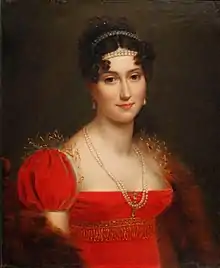

Ney married Aglaé Louise (Paris, 24 March 1782 – Paris, 1 July 1854), daughter of Pierre César Auguié (1738–1815) and Adélaïde Henriette Genet (1758–1794, sister of Henriette Campan and Citizen Genêt), at Thiverval-Grignon on 5 August 1802.[41][42] they had four sons:
- Joseph Napoléon, 2nd Prince de la Moskowa (Paris, 8 May 1803 – Saint-Germain-en-Laye, 25 July 1857). He married Albine Laffitte (Paris, 12 May 1805 – Paris, 18 July 1881) in Paris on 26 January 1828. Albine was the daughter of Jacques Laffitte, Governor of the Bank of France. They had two children, whose male blood line ended.
Joseph also had an illegitimate son who was married and died childless.
- Michel Louis Félix, recognized as 2nd Duc d'Elchingen in 1826 (born 24 August 1804 in Paris – died 14 July 1854 at Gallipoli, during the Crimean War). He married Marie-Joséphine (Lubersac (20 December 1801 – Versailles, 1 July 1889), daughter of Joseph Souham, in Paris on 19 January 1833.
- Eugène Michel (Paris, 12 July 1806 – Paris, 25 October 1845). He died unmarried.
- Edgar Napoléon Henry, recognized as 3rd Prince de la Moskowa 1857 (Paris, 12 April 1812 – Paris, 4 October 1882). He married Clotilde de La Rochelambert (Saint-Cloud, 29 July 1829 – Paris, 1884) in Paris on 16 January 1869. Their marriage was childless and the title of Prince de la Moskowa then reverted to Michel's descendants.
In literature
- Ney appears briefly at the beginning of Stendhal's novel The Charterhouse of Parma, when Fabrizio del Dongo inadvertently joins his Bodyguard at the Battle of Waterloo.
- Ney is a character in Leo Tolstoy's epic novel War and Peace. See List of War and Peace characters.
- Ney is mentioned and/or appears in several of Sir Arthur Conan Doyle's Brigadier Gerard stories, including Brigadier Gerard at Waterloo (1903).
- Ney's patriotism, his intelligence, and his courage during the Battle of Waterloo was extensively mentioned and praised by Victor Hugo in his novel Les Misérables.
- Ney appears as a minor character in two volumes of Bernard Cornwell's Richard Sharpe series, Sharpe's Siege and Sharpe's Revenge
In film and television
Ney has been portrayed by (among others):
- Carl de Vogt in the 1929 film Waterloo.
- Aleksandr Stepanov in the 1944 Russian film Kutuzov.
- Dan O'Herlihy in the 1970 film Waterloo.
- John Baker in the 1972 British series War and Peace.
- Colin Bean in the episode "A Soldier's Farewell" of the British sitcom Dad's Army.
- Alain Doutey in the miniseries Napoléon.
- Jordi Martínez in the episode "El ministerio del tiempo" of the Spanish television series El ministerio del tiempo.
- John Burton in the 1938 film Bravest of the Brave.
See also
- HMS Marshal Ney, a British warship named after Ney
Notes
- Riotor, Léon (1934). Amours et tragédie de Michel Ney, maréchal de France (in French). Fasquelle éditeurs. p. 7.
- Chandler 1999, p. 360
- Young 1987, p. 360.
- Atteridge 1912.
- Atteridge 1912, p. 25.
- Six 1934, p. 253.
- Phipps (2011), p. 164.
- Chandler 1999, p. 314
- Grehan, John (2015). The lines of Torres Vedras : the cornerstone of Wellington's strategy in the Peninsular War, 1809-1812. Frontline Books. ISBN 9781473852747.
- Paul Holzhausen (1912) Die Deutschen in Russland, 1812. Leben und Leiden auf der Moskauer Heerfahrt. Morawe & Scheffelt, Berlin, p. 73
- Leadership by Inspiration: An Episode of Marshal Ney during the Russian Retreat By Wayne Hanley West Chester University of Pennsylvania
- Holzhausen, p. 74
- Photos of the Losvinka and Dniepr by Elena Minina, Smolensk
- The real places of the crossing of Marshal Ney's 3rd Corps on November 6/18 and how it took place
- "The bravest of the brave, Michel Ney, marshal of France, duke of Elchingen, prince of the Moskowa 1769-1815" by A. HILLIARD ATTERIDGE
- The real places of the crossing of Marshal Ney's 3rd Corps on November 6/18 and how it took place
- Rickard, J (26 June 2014), Second battle of Krasnyi, 15-18 November 1812, http://www.historyofwar.org/articles/battles_krasnyi_2nd.html
- A Global Chronology of Conflict: From the Ancient World to the Modern Middle East by Spencer C. Tucker
- Michel Ney’s Retreat by Jeremy Green
- The real places of the crossing of Marshal Ney's 3rd Corps on November 6/18 and how it took place
- MARSHAL NEY by Sergey Zakharov
- Y. Tarlé (1938) Napoleon's Invasion of Russia, 1812. Chapter X
- Gates 2003, p. 259.
- Le Journal de Paris, 22 novembre 1815; Journal des débats politiques et littéraires, 22 novembre 1815
- (Markham 2003, p. 261).
- Chandler 1999, p. 315
- Roberts 2005, p. 116.
- Markham 2003, p. 272.
- Markham 2003, p. 276.
- Howarth 1968, p. 132.
- Parry 1901, p. 68.
- "venez voir comment meurt un maréchal de France!" Coustumier 2011, p. 267.
- Gillespie-Payne 2003, p. 111.
- Welschinger, Henri. Le Maréchal Ney: 1815. Paris: Librairie Plon, 1893.
- Le Journal de Paris, 22 novembre 1815; Journal des débats politiques et littéraires, 22 novembre 1815
- "Je suis Français et je resterai Français!" Bellemare & Nahmias 2009, p. 149
- Macdonell 1934, p. 328.
- Tsouras 2005, p. 245
- "Peter Stuart Ney Confesses to be Napoleon's Closest Aide". North Carolina Department of Natural and Cultural Resources. 15 November 2016. Retrieved 24 May 2020.
- Taylor, George V. (1991). "Ney, Peter Stewart". In Powell, William S. (ed.). Dictionary of North Carolina Biography. University of North Carolina Press. Retrieved 16 March 2021.
- Atteridge 1912, pp. 107–109.
- The paternal grandparents of Aglaé (Ney's wife) were Pierre César Auguié (1708–1776) and Marie Guary (1709–1788); her maternal grandparents were Edmé Jacques Genet (1726–1781) and Marie Anne Louise Cardon, who were the parents of Edmond-Charles Genêt and Jeanne-Louise-Henriette Campan (Atteridge 1912, pp. 107–109).
References
- Atteridge, A. Hilliard (1912). Marshal Ney: The Bravest of the Brave. London: Methuen.
- Bellemare, Pierre; Nahmias, Jean-François (2009). La Terrible vérité: 26 grandes énigmes de l'histoire enfin résolues (in French). Albin Michel. p. 149. ISBN 978-2-226-19676-7.
- Chandler, David (1999). Dictionary of the Napoleonic wars. Wordsworth editions.
- Coustumier, Jacques Le (2011). Le Maréchal Victor (in French). Nouveau Monde éditions. p. 267. ISBN 978-2-36583-087-4.
- Gates, David (2003). The Napoleonic Wars, 1803–1815. Pimlico.
- Gillespie-Payne, Jonathan (2003). Waterloo: In the Footsteps of the Commanders. Pen and Sword. p. 111. ISBN 978-1-84415-024-3.
- Howarth, David (1968) [1975]. Waterloo: Day of Battle. New York: Galahad Books. p. 132. ISBN 0-88365-273-0.
- Horricks, Raymond (1982). Marshal Ney, The Romance And The Real. Tunbridge Wells: Midas Books. ISBN 0-85936-276-0.
- Kircheisen, F.M. (2010). Memoires Of Napoleon I. Retrieved 9 August 2021.
- Macdonell, A. G. (1934). Napoleon and His Marshals. London: Macmillan.
- Markham, J. D. (2003). Napoleon's Road to Glory: Triumphs, Defeats, and Immortality. Brassey’s.
- Parry, D. H. (1901). Battles of the Nineteenth Century. Vol. 1 (special ed.). London, Paris, New York and Melbourne: Cassell and Company. p. 68.
- Roberts, A. (2005). Waterloo, June 18, 1815: The Battle for Modern Europe. Harper-Collins.
- Six, Georges (1934). "Ney, duc d'Elghingen, prince de la Moscowa (Michel)". Dictionnaire biographique des généraux et amiraux français de la Révolution et de l'Empire: 1792–1814 (in French). Vol. 2. Paris: Librairie Historique et Nobilaire. pp. 253–255.
- Tsouras, P. G. (2005). The book of Military Quotations. Zenith Press.
- Young, Peter (1987). "The Bravest of the Brave: Ney". In Chandler, David (ed.). Napoleon's Marshals. London: Weidenfeld and Nicolson. pp. 357–380. ISBN 0-297-79124-9.
Further reading
- Dawson, Paul L. Marshal Ney at Quatre Bras: New Perspectives on the Opening Battle of the Waterloo Campaign (Pen and Sword, 2017).
- Kurtz, Harold (1957). The Trial of Marshal Ney: His Last Years and Death. New York: Alfred A. Knopf.
- R. F. Delderfield (1966) Napoleon's Marshals
.svg.png.webp)